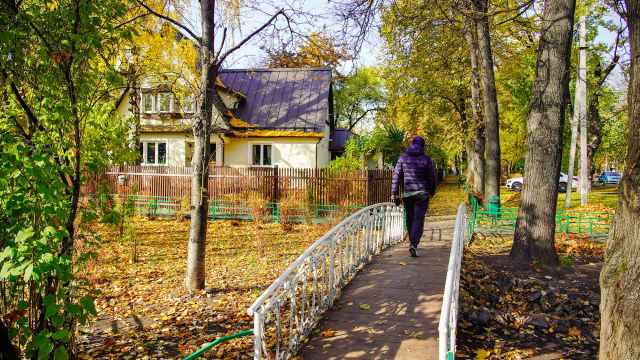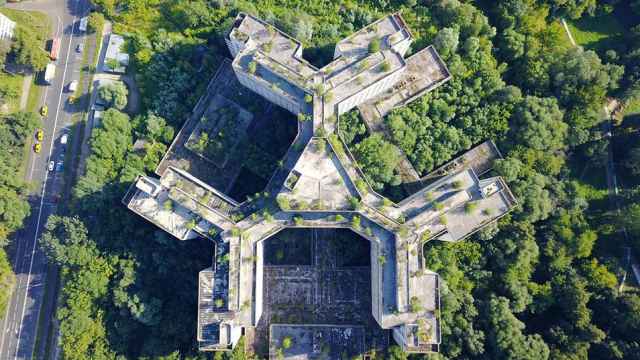Gorodok Chekistov
When authorities decided in the 1920s to make Yekaterinburg the industrial powerhouse of the Urals, the city had to grow — and fast. Several prominent architects were dispatched from Moscow and as constructivism was in vogue at the time, Yekaterinburg became the capital of the movement. Whole neighborhoods were razed to the ground and new ones were built from scratch; many of the neighborhoods were named after their residents’ professions: town of workers, town of lawyers, and, most famous of all, town of NKVD (secret police) specialists, called “gorodok chekistov,” with buildings 5-10 stories high. The most prominent of the buildings is the white horseshoe-shaped Iset hotel (Prospekt Lenina, 69, Bldg. 1). In its current dilapidated state, only some parts of the building can be used, but there are plans for a complete restoration. After a contemporary art biennale took place there a few years ago, the Iset hotel became one of the new symbols of the city.
Metenkov House
Metenkov House is a small photography museum in a wooden mansion that once belonged to Veniamin Metenkov, one of the city’s first professional photographers. There is no permanent collection, but there are always two or three temporary exhibitions on view, with everything from photos by Metenkov himself to cutting-edge contemporary art. Don’t miss the antique camera store on the first floor.
OPEN noon to 8 p.m.; closed Monday
TICKETS 50-150 rubles
Ulitsa Karla Libknekhta, 36 dommetenkova.ru

Other Constructivist Gems
Since Yekaterinburg is unofficially “the capital of constructivism,” there are plenty of other architectural gems. Take an afternoon and just walk around to see what the city has to offer. Across the street from the Iset hotel is the City Center shopping mall, which used to combine the Construction Workers’ Club and Sverdlovsk Film Studio. Today the whole interior is made up of various stores, but you can still admire the stunning exterior (Prospekt Lenina, 50). Further down the street, there’s Dom Pechati (House of Press), formerly the headquarters and printing house for several local newspapers; today it is the home of a night club, as well as several bars, restaurants and shops. The courtyard has some stunning graffiti, by both local and visiting artists, while the exterior sports the famous constructivist “ribbon” windows (Prospekt Lenina, 49). Two other buildings worth checking out on Prospekt Lenina are the Central Post Office (#39), where the first two floors are accessible to the public, and the Oblispolkom building (#34), the former home of the local Communist Party executive committee. Right across the City Pond from the Yeltsin Center is the sprawling Dynamo sports complex, built in the early 1930s (Ulitsa Vasilia Yeryomina, 12). Dynamo includes both a sports club and a stadium and looks like a blue and white ship standing in the docks.
Unit F
Unit F (Yacheyka F) is a tiny museum that takes up just one apartment in a constructivist Gorpromural building designed by Moisei Ginzburg, the architect behind one of constructivism’s most iconic buildings — the Narkomfin building in Moscow. Since Narkomfin is closed, Gorpromural is the only place you can view Ginzburg’s ingenious two-story apartment designs, walk down the corridor occupied by local painters and even access the roof if you’re lucky. The Unit F museum is open all day on Saturdays and by arrangement the rest of the week. You can find plenty of background on Gorpromural construction, as well as stories of its original residents, many of whom were repressed during Stalin’s purges.
TICKETS Call ahead or send a message on Facebook
Ulitsa Malysheva, 21/1 (dial 38 on intercom) facebook.com/FlatUnitF

Kamenniye Palatki
Kamenniye Palatki (Stone Tents) on the outskirts of Yekaterinburg is the Ural region’s very own Stonehenge. Reachable by trams 13 and 15 (on Ulitsa Vysotskogo, 11), these rock formations are located in a park that stretches all the way to Lake Shartash. The area around the lake is where the remains of the first prehistoric settlements were found. The jury’s still out on how much of Stone Tents was formed by nature and how much by human hands, or whether it had a religious purpose. There’s still debate even about the name — whether it refers to “tents” or the word polati, which means “bunk bed.” This is a popular picnic spot with locals and if the weather is good, spend a few hours wandering around the forest. It’s also a popular biking area and there are bike rental facilities — be sure to bring your passport. If you fancy a dip to cool off, the lake is safe for swimming.
Uralmash
Uralmash is a city within the city. It’s a heavy machine production facility that takes up an entire district, and was completed in 1933. Here, constructivist ideas about communal housing and living were fully implemented. The symbol of Uralmash is the White Tower (Ulitsa Bakinskikh Komissarov, 2a, Bldg. 1) a long-legged water tower that looks like something out of “Star Wars.” Other interesting buildings include a combination factory-kitchen (a constructivist term for a self-sufficient cafeteria) and a cultural center (Bulvar Kultury, 3). About half of the building was destroyed by a fire, but the rest is accessible to visitors. Another derelict building is Hotel Madrid, which looks like a constructivist palace, with decorated columns and peeling burnt Sienna paint (Ulitsa Mashinostroitelei, 4). All of these buildings are within walking distance of the Uralmash metro station.
A Message from The Moscow Times:
Dear readers,
We are facing unprecedented challenges. Russia's Prosecutor General's Office has designated The Moscow Times as an "undesirable" organization, criminalizing our work and putting our staff at risk of prosecution. This follows our earlier unjust labeling as a "foreign agent."
These actions are direct attempts to silence independent journalism in Russia. The authorities claim our work "discredits the decisions of the Russian leadership." We see things differently: we strive to provide accurate, unbiased reporting on Russia.
We, the journalists of The Moscow Times, refuse to be silenced. But to continue our work, we need your help.
Your support, no matter how small, makes a world of difference. If you can, please support us monthly starting from just $2. It's quick to set up, and every contribution makes a significant impact.
By supporting The Moscow Times, you're defending open, independent journalism in the face of repression. Thank you for standing with us.
Remind me later.






